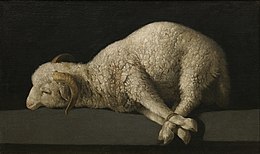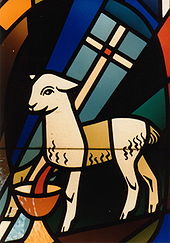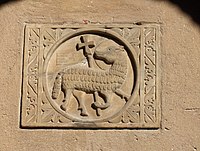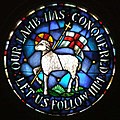Lamb of God

Lamb of God (Greek: Ἀμνὸς τοῦ Θεοῦ, romanized: Amnòs toû Theoû; Latin: Agnus Dei, Ecclesiastical Latin: [ˈaɲ.ɲus ˈde.i]) is a title for Jesus that appears in the Gospel of John. It appears at John 1:29, where John the Baptist sees Jesus and exclaims, "Behold the Lamb of God who takes away the sin of the world."[1] It appears again in John 1:36.
Christian doctrine holds that a divine Jesus chose to suffer crucifixion at Calvary to save the world from its sins. He was given up by divine Father, as an "agent and servant of God" in carrying away the sins of the world.[2][3] In Christian theology the Lamb of God is viewed as both foundational and integral to the message of Christianity.[4][5]
A lion-like lamb that rises to deliver victory after being slain appears several times in the Book of Revelation.[6] It is also referred to in Pauline writings; 1 Corinthians 5:7 suggests that Saint Paul intends to refer to the death of Jesus, who is the Paschal Lamb, using the theme found in Johannine writings.[7]
The Lamb of God title is widely used in Christian prayers. The Latin version, Agnus Dei , and translations are a standard part of the Catholic Mass, as well as the classical Western Liturgies of the Anglican and Lutheran churches. It is also used in liturgy and as a form of contemplative prayer.[8][9] The Agnus Dei also forms a part of the musical setting for the Mass.
As a visual motif the lamb has been most often represented since the Middle Ages as a standing haloed lamb with a foreleg cocked "holding" a pennant with a red cross on a white ground, though many other ways of representing it have been used.
Gospel of John
[edit]

The title Lamb of God for Jesus appears in the Gospel of John, with the initial proclamation: "Behold the Lamb of God who takes away the sin of the world" in John 1:29, the title reaffirmed the next day in John 1:36.[1] The second use of the title Lamb of God takes place in the presence of the first two apostles of Jesus, who immediately follow him, address him as Rabbi with respect and later in the narrative bring others to meet him.[10]


These two proclamations of Jesus as the Lamb of God closely bracket the Baptist's other John 1:34: "I have borne witness that this is the Son of God". From a Christological perspective, these proclamations and the descent of the Holy Spirit as a dove in John 1:32 reinforce each other to establish the divine element of the Person of Christ.[1] In Johannine Christology the proclamation "who takes away the sin of the world" begins the unfolding of the salvific theme of the redemptive and sacrificial death of Jesus followed by his resurrection which is built upon in other proclamations such as "this is indeed the Saviour of the world" uttered by the Samaritans in John 4:42.[11][12]
Book of Revelation
[edit]The Book of Revelation includes over twenty-nine references to a lion-like lamb ("slain but standing") which delivers victory in a manner reminiscent of the resurrected Christ.[6] In the first appearance of the lamb in Revelation (5:1–7) only the lamb (which is of the tribe of Judah, and the root of David) is found worthy to take the judgment scroll from God and break the seals.[6] The reference to the lamb in Revelation 5:6 relates it to the Seven Spirits of God which first appear in Revelation 1:4 and are associated with Jesus who holds them along with seven stars.[13]
In Rev. 19:6-9, the lamb is said to be having a wedding feast, and that his bride's pure linen garment is said to be the "righteous acts of the saints."[14] A wedding feast, in Jewish law, is an obligatory banquet after a Jewish wedding.[15] In Jewish eschatology, the messiah will hold a wedding feast with the righteous of every nation (people), called a Seudat Chiyat HaMatim, wherein the messiah and his wedding guests will feast on the flesh of the Leviathan.[16] The identity of the lamb's bride is not specified in the passage, but the Christian Church is referred to as the bride of Christ elsewhere in the New Testament.
In Revelation 21:14 the lamb is said to have twelve apostles.[6] The handing of the scroll (i.e. the book containing the names of those who will be saved) to the risen lamb signifies the change in the role of the lamb. In Calvary, the lamb submitted to the will of the Father to be slain, but now is trusted with the judgment of mankind.[17]
From the outset, the book of Revelation is presented as a "revelation of Jesus Christ" and hence the focus on the lamb as both redeemer and judge presents the dual role of Jesus: he redeems man through self-sacrifice, yet calls man to account on the day of judgment.[18]
Christology
[edit]The concept of the Lamb of God fits well within John's "agent Christology", in which sacrifice is made as an agent of God or servant of God for the sake of eventual victory.[3][19]
The theme of a sacrificial lamb which rises in victory as the Resurrected Christ was employed in early Christology. For example, in 375 Saint Augustine wrote: "Why a lamb in his passion? Because he underwent death without being guilty of any iniquity. Why a lion in his passion? Because in being slain, he slew death. Why a lamb in his resurrection? Because his innocence is everlasting. Why a lion in his resurrection? Because everlasting also is his might."[20]

The 11th century Christology of Saint Anselm of Canterbury specifically disassociates the Lamb of God from the Old Testament concept of a scapegoat, which is subjected to punishment for the sins of others without knowing it or willing it.[2] Anselm emphasized that as Lamb of God, Jesus chose to suffer in Calvary as a sign of his full obedience to the will of the Father.[2]
John Calvin presented the same Christological view, of "The Lamb as the agent of God", by arguing that in his trial before Pilate and while at Herod's Court Jesus could have argued for his innocence, but instead remained mostly quiet and submitted to crucifixion in obedience to the Father, for he knew his role as the Lamb of God.[21][22]
In modern Eastern Orthodox Christology, Sergei Bulgakov argued that the role of Jesus as the Lamb of God was "pre-eternally" determined by the Father, before the creation of the world, by considering the scenario that it would be necessary to send The Son as an agent to redeem humanity disgraced by the fall of Adam, and that this is a sign of His love.[23]

Multiple hypotheses about the suitable symbolism for the Lamb of God have been offered, within various Christological frameworks, ranging from the interpretation of Old Testament references to those of the Book of Revelation.[24] One view suggests the symbolism of Leviticus 16 as scapegoat, coupled with Romans 3:21–25 for atonement, while another view draws parallels with the Paschal Lamb in Exodus 12:1–4, coupled with John 1:29–36, and yet another symbolism relies on Revelation 5:5–14 in which the lamb is viewed as a lion who destroys evil.[24][25] However, as above, the view adopted by Saint Anselm and John Calvin rejects the scapegoat symbolism. They view Jesus as making a knowing sacrifice as an agent of God, unlike an unwitting scapegoat.[2][21][22]
In modern Roman Catholic Christology, Karl Rahner has continued to elaborate on the analogy that the blood of the Lamb of God, and the water flowing from the side of Christ on Calvary, had a cleansing nature, similar to baptismal water. In this analogy, the blood of the Lamb washed away the sins of humanity in a new baptism, redeeming it from the fall of Adam.[26]
Liturgy and music
[edit]In the Mass of the Roman Rite and also in the Eucharist of the Anglican Communion, the Lutheran Church, and the Western Rite of the Eastern Orthodox Church the Agnus Dei is the invocation to the Lamb of God sung or recited during the fraction of the Host.[27] It is said to have been introduced into the Mass by Pope Sergius I (687–701).[28]
Agnus Dei has been set to music by many composers, usually as part of a Mass setting.[29][30]
Art
[edit]In Christian iconography, an Agnus Dei is a visual representation of Jesus as a lamb, since the Middle Ages, usually carrying a halo and holding a standard or banner with a cross and symbolizing the victory.[31] This normally rests on the lamb's shoulder and is held in its right foreleg. Often the cross will have a white banner suspended from it charged with a red cross (similar to St George's Cross), though the cross may also be rendered in different colors. Sometimes the lamb is shown lying atop a book with seven seals hanging from it. This is a reference to the imagery in the Book of Revelation 5:1–13, ff. Occasionally, the lamb may be depicted bleeding from the area of the heart (Cf. Revelation 5:6), symbolizing Jesus' shedding of his blood to take away the sins of the world (Cf. John 1:29, 1:36).
In Early Christian art the symbol appears very early on. Several mosaics in churches include it, some showing a row of twelve sheep representing the apostles flanking the central Agnus Dei, as in Santi Cosma e Damiano, Rome (526–30). Agnus Dei is standing on a hill with four rivers of Paradise flowing out underneath.[31]
The Moravian Church uses an Agnus Dei as their seal with the surrounding inscription Vicit agnus noster, eum sequamur ("Our Lamb has conquered, let us follow him").
Although the depiction of Jesus as the Lamb of God is of ancient origin, it is not used in the liturgical iconography of the Eastern Orthodox Church. The reason for this is that the depictions of Jesus in the Orthodox Church are anthropomorphic rather than symbolic, as a confession of the Orthodox belief in the Incarnation of the Logos. However, there is no objection to the application of the term "Lamb of God" to Jesus. In fact, the Host used in the Orthodox Divine Liturgy is referred to as the Lamb (Greek: άμνος, romanized: amnos; Church Slavonic: Агнец, romanized: Agniets). In 692 AD the Synod of Constantinople prohibited using a depiction of lamb as a symbol of Christ, a point which was adopted in the East but not the West.[31]
Lamb of God is also part of Easter decorations.[32]
Heraldry
[edit]A paschal lamb is a charge used in heraldry, for example as the crest of the Davie Baronets, and is blazoned: a paschal lamb[33] This charge is depicted as a lamb standing with body facing towards the dexter (viewer's left), with nimbus, and with head facing forwards (or turned looking backwards to sinister, termed reguardant) holding under its right foreleg a flagpole, tipped with a small cross, resting at a diagonal angle over its shoulder, flying a banner of the Cross of St. George (except in Perth's coat of arms, where it flies a banner of the Cross of St Andrew).
Catholic sacramental
[edit]In the Roman Catholic Church, an Agnus Dei is a disc of wax, stamped with an image of Jesus as a lamb bearing a cross, that is consecrated by the pope as a sacramental.[34] These were often set in jewelry, and might be worn round the neck on a chain, or as a brooch.
Gallery
[edit]-
The Coat of arms of Puerto Rico features the Lamb of God and other symbols including the Kingdom of Jerusalem Cross and the Catholic Monarchs initials.
-
Brass Agnus Dei from altar-front in the Cathedral of the Assumption in Louisville, Kentucky
-
Agnus Dei on the 1311 coin of King Philip IV of France
-
Eucharistic Pall, embroidered with the Agnus Dei reposing on the book of the Seven Seals
-
Stained glass Lamb of God carrying the vexillum, Royal Military College of Canada
-
Modern copy of a Romanesque Agnus Dei, Santiago de Compostela, Galicia
-
The Agnus Dei on Perth, Scotland's coat of arms holds the Scottish flag.
-
13th century depiction of a seven-eyed lamb
-
The Agnus Dei on the coat of arms of the Roman Catholic Diocese of Chengdu
-
Behold the lamb of God by Alexandre Bida
-
The Lamb of God in the coat of arms of Grasse, France.
See also
[edit]References
[edit]Citations
[edit]- ^ a b c Bulgakov 2008, p. 263.
- ^ a b c d Deme 2003, pp. 199–200.
- ^ a b Cullmann 1959, p. 79.
- ^ Gerlach 1998, p. 22.
- ^ Hoffmann 2005, p. 117.
- ^ a b c d Glabach 2007.
- ^ Chrysostom 1889.
- ^ Linman 2010, p. 148.
- ^ Marshall 1989, p. 369.
- ^ Redford 2007, pp. 100–101.
- ^ Pollard 2005, p. 21.
- ^ Hengel 2004, p. 371.
- ^ Schreiner 2008, p. 502.
- ^ Revelation 19:6–9
- ^ Shulman, Shlomo (n.d.). "Guide to the Jewish Wedding". aish.com. Retrieved 14 October 2021.
- ^ Hirsch, Emil G.; Kohler, Kaufmann; Schechter, Solomon; Broydé, Isaac (n.d.). "Leviathan and Behemoth". jewishencyclopedia.com. Retrieved 14 October 2021.
- ^ DeHaan 1998, p. 103.
- ^ Witherington 2003, p. 27.
- ^ Sadananda 2004, p. 281.
- ^ Weinrich & Oden 2005, p. 73.
- ^ a b Old 1998, p. 125.
- ^ a b Edmondson 2004, p. 91.
- ^ Bulgakov 2008, p. 129.
- ^ a b Neville 2001, p. 13.
- ^ Köstenberger et al. 2012, p. 114.
- ^ Rahner 1975, p. 74.
- ^ Henry 1907.
- ^ Lieuwen, Reader Daniel (n.d.). "Lives of Orthodox Western Saints". orthodox.net. McKinney TX – via St Nicholas Orthodox Church.
- ^ Randel 2003, p. 28.
- ^ Atkinson 1975, p. 14.
- ^ a b c Murray, Peter; Murray, Linda (1998). "Agnus Dei". The Oxford Companion to Christian Art and Architecture. Oxford University Press. p. 6. ISBN 978-0-19-860216-3. OCLC 1055176997.
- ^ Kowalczyk, Maria (2020). "Geneza i obchód Wielkanocy w Polsce. Zarys problematyki" (PDF). Studia Elbląskie (in Polish). XX: 273–294.
- ^ Montague-Smith 1968, p. 232.
- ^ Thurston 1907.
Sources
[edit]- Atkinson, C.M. (1975). The Earliest Settings of the Agnus Dei and Its Tropes. University of North Carolina at Chapel Hill.
- Bulgakov, Sergei (2008). The Lamb of God. Wm. B. Eerdmans. ISBN 978-0-8028-2779-1.
- Cullmann, O. (1959). The Christology of the New Testament. The New Testament library. Presbyterian Publishing Corporation. ISBN 978-0-664-24351-7.
- Chrysostom, John (1889). "Homily 15 on First Corinthians". In Philip Schaff (ed.). Nicene and Post-Nicene Fathers, First Series. Vol. 12. Translated by Talbot W. Chambers. Buffalo, NY: Christian Literature Publishing Co. – via New Advent.
- DeHaan, M. R. (1998). Studies in Revelation. Grand Rapids, MI: Kregel Publications. ISBN 0-8254-2485-2. OCLC 39256374.
- Deme, Daniel (2003). The Christology of Anselm of Canterbury. Aldershot, Hampshire, England Burlington, VT: Ashgate. ISBN 0-7546-3779-4. OCLC 51855472.
- Edmondson, Stephen (2004). Calvin's Christology. Cambridge New York: Cambridge University Press. ISBN 0-521-54154-9. OCLC 70891446.
- Gerlach, Karl (1998). The Antenicene Pascha: A Rhetorical History. Peeters. ISBN 9789042905702.
- Glabach, Wilfried (2007). Reclaiming the book of Revelation : a suggestion of new readings in the local church. New York: Peter Lang. ISBN 978-1-4331-0054-3. OCLC 77333939.
- Hengel, M. (2004). Studies in Early Christology. Academic Paperback Series. Bloomsbury Academic. ISBN 978-0-567-04280-4.
- Henry, Hugh Thomas (1907). . In Herbermann, Charles (ed.). Catholic Encyclopedia. Vol. 1. New York: Robert Appleton Company.
- Hoffmann, Matthias Reinhard (2005). The Destroyer and the Lamb: The Relationship Between Angelomorphic and Lamb Christology in the Book of Revelation. Mohr Siebeck. p. 117. ISBN 3-16-148778-8.
- Köstenberger, A.J.; Kellum, L.S.; Quarles, C.L.; Quarles, C.L. (2012). The Lion and the Lamb: New Testament Essentials from the Cradle, the Cross, and the Crown. B&H Publishing Group. ISBN 978-1-4336-7708-3.
- Marshall, Paul (1989). Prayer book parallels : the public services of the church arranged for comparative study. New York: Church Hymnal Corp. ISBN 0-89869-181-8. OCLC 20641209.
- Linman, Jonathan (2010). Holy conversation : spirituality for worship. Minneapolis, MN: Fortress Press. ISBN 978-0-8006-2130-8. OCLC 840417015.
- Montague-Smith, P.W., ed. (1968). Debrett's Peerage, Baronetage, Knightage and Companionage. Kingston-upon-Thames: Kelly's Directories.
- Neville, Robert (2001). Symbols of Jesus : a Christology of symbolic engagement. Cambridge: University Press. ISBN 0-521-00353-9. OCLC 46866407.
- Old, Hughes (1998). The reading and preaching of the scriptures in the worship of the Christian church. Grand Rapids, Mich: W.B. Eerdmans. ISBN 0-8028-4775-7. OCLC 37392859.
- Pollard, T. E. (2005). Johannine Christology and the early Church. Cambridge New York: Cambridge University Press. ISBN 0-521-01868-4. OCLC 60320185.
- Rahner, K. (1975). Encyclopedia of Theology: A Concise Sacramentum Mundi. Bloomsbury Academic. ISBN 978-0-86012-006-3.
- Randel, D.M., ed. (2003). The Harvard Dictionary of Music: Fourth Edition. Harvard University Press reference library. Harvard University Press. ISBN 978-0-674-01163-2.
- Redford, Doug (2007). The life and ministry of Jesus : the Gospels. Cincinnati, OH: Standard Pub. ISBN 978-0-7847-1900-8. OCLC 71350394.
- Sadananda, D.R. (2004). The Johannine Exegesis of God: An Exploration Into the Johannine Understanding of God. Beihefte. Walter de Gruyter. ISBN 978-3-11-018248-4.
- Schreiner, T.R. (2008). New Testament Theology: Magnifying God in Christ. Baker Publishing Group. ISBN 978-0-8010-2680-5.
- Thurston, Herbert (1907). . In Herbermann, Charles (ed.). Catholic Encyclopedia. Vol. 1. New York: Robert Appleton Company.
- Weinrich, W.C.; Oden, T.C. (2005). Revelation. Ancient Christian Commentary on Scripture. InterVarsity Press. ISBN 978-0-8308-1497-8.
- Witherington, Ben (2003). Revelation. Cambridge, U.K. New York: Cambridge University Press. ISBN 978-0-521-00068-0. OCLC 51223519.
External links
[edit] Media related to Agnus Dei at Wikimedia Commons
Media related to Agnus Dei at Wikimedia Commons














